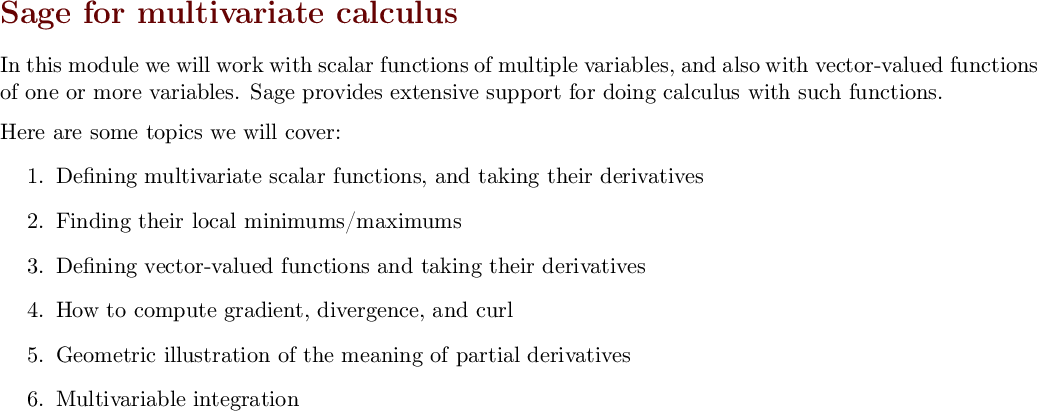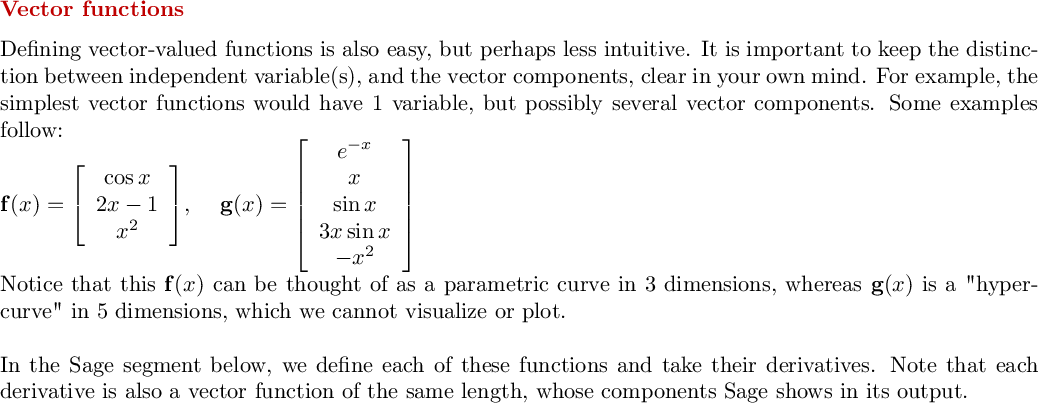

# A function of 3 variables: f(x,y,z) = (x^2 + y^2) * z # Can evaluate the function at any point: f(1,0,2) # There are several ways to get partial derivatives: f.diff(x) f.derivative(x) derivative(f,x) derivative(f,z) # Note that the answer is returned in function notation, # with inputs to the left and outputs to the right of the arrow. # It is easy to compute the gradient of f: f.gradient()
2
(x, y, z) |--> 2*x*z
(x, y, z) |--> 2*x*z
(x, y, z) |--> 2*x*z
(x, y, z) |--> x^2 + y^2
(x, y, z) |--> (2*x*z, 2*y*z, x^2 + y^2)


# Step 0: Define the function: g(x,y) = 100*(y - x^2)^2 + (1 - x)^2 # Step 1: Find the points where the gradient of g = 0: gx(x,y) = derivative(g,x) # Find derivative of g with respect to x. gy(x,y) = derivative(g,y) # Derivative of g with respect to y. results = solve([gx == 0, gy ==0], (x,y), solution_dict=True) # Note that results[0] is a dictionary containing the solutions xval = results[0][x] yval = results[0][y] print "Gradient is 0 at: x =", xval, "y =", yval # Step 2: Check sign of gxx and determinant of Hessian matrix at those points: gh = g.hessian() # Find the Hessian matrix (in function form) gh(xval,yval).determinant() # Compute its determinant at (1,1) gxx(x,y) = derivative(gx,x) # Find gxx as function of (x,y) gxx(xval,yval) # Compute its value at (1,1) # Step 3: Since the Hessian and gxx are both positive at (1,1), it is a local minimum. # Answer: g(1,1)=0 is a local minimum of the given function g(x,y). # Since grad(g) != 0 anywhere else, there is no other # local minimum/maximum.
Gradient is 0 at: x = 1 y = 1
400
802

# It is important to keep the distinction between independent variable(s), # and the vector components, clear in your own mind. x = var('x') # The single independent variable # (1) A 3-component vector: fv = vector( (cos(x), 2*x-1, x^2) ) fv(x=4) # Evaluate fv at x=4. Note that fv(4) also currently works, but is to be discontinued soon. derivative(fv, x) # 1st derivative of fv (which is also a vector function). parametric_plot(fv, (x,-2,3), thickness='3') # Just to see what the function looks like. # (2) A 5-component vector and its derivative: gv = vector( (e^-x, x, sin(x), 3*x*sin(x), -x^2) ) derivative(gv, x)
(cos(4), 7, 16)
(-sin(x), 2, 2*x)
3D rendering not yet implemented
(-e^(-x), 1, cos(x), 3*x*cos(x) + 3*sin(x), -2*x)

# Here's how to define vector functions of multiple variables. # Notice, it is an intuitive generalization of the previous syntax. # x, y, z = var('x, y, z') f = vector( (x^2 + y^2, 3*x*y)) g = vector( (x^2 * y, x^2 * z, y*z) ) # You can evaluate the functions at any specific point by # similarly generalizing the single variable syntax. # (I've used the print command just to show the output clearly): print "f(0,2)=", f(x=0, y=2) print "g(1,2,3)=", g(x=1, y=2, z=3) # Find divergence and curl. Note, the syntax requires # specifying the names of the variables in order. (Again, # the print command is just to show the output clearly): print "div(f)=", f.div([x,y]) print "curl(f)=", f.curl([x,y]) print "div(g)=", g.div([x,y,z]) print "curl(g)=", g.curl([x,y,z])
f(0,2)= (4, 0)
g(1,2,3)= (2, 3, 6)
div(f)= 5*x
curl(f)= y
div(g)= 2*x*y + y
curl(g)= (-x^2 + z, 0, -x^2 + 2*x*z)

# It is easy to find partial derivatives. Note that each # partial derivative is itself a vector function. print "partial derivatives of f:" derivative(f, x) # partial of f with respect to x. derivative(f, y) # partial of f with respect to y. print " " print "partial derivatives of g:" derivative(g, x) # partial of g with respect to x. derivative(g, y) # partial of g with respect to y. derivative(g, z) # partial of g with respect to z.
partial derivatives of f:
(2*x, 3*y)
(2*y, 3*x)
partial derivatives of g:
(2*x*y, 2*x*z, 0)
(x^2, 0, z)
(0, x^2, y)

# Example to illustrate the meaning of partial derivatives in a 2-variable function. # x-derivative gives tangent line parallel to x-direction; # y-derivative gives tangent line parallel to y-direction. x, y, t = var('x y t') fs = sin(x) + cos(y) # An example function Q = plot3d(fs, (x,-3,3), (y,-3,3) ) fsx = derivative(fs,x) # Derivative in x-direction fsy = derivative(fs,y) # Derivative in y-direction xp = 1.5; yp = -1 # Some sample point in the domain of interest # Tangent in x-direction in parametric form: (xp+t, yp, fsx*t+fs) R = parametric_plot( (t+xp, yp, t*fsx(x=xp,y=yp)+fs(x=xp,y=yp)), (t,-3,3), thickness=3, color='green' ) # Tangent in y-direction in parametric form: (xp, yp+t, fsy*t+fs) S = parametric_plot( (xp, t+yp, t*fsy(x=xp,y=yp)+fs(x=xp,y=yp)), (t,-3,3), thickness=3, color='yellow' ) T = point([xp,yp,fs(x=xp,y=yp)], size=10, color='black') show(Q+R+S+T)
3D rendering not yet implemented

Interact: please open in CoCalc

# Tangent plane example. Here the tangent plane at the point (c,d) has # the parametric form: x = s+c, y = t+d, z = s*fx(c,d) + t*fy(c,d) + f(c,d) # for $s, t \in (-\infty,\infty)$. x, y, s, t = var('x y s t') fs = sin(x) + cos(y) Q = plot3d(fs, (x,-3,3), (y,-3,3) ) fsx = derivative(fs,x) # Derivative in x-direction fsy = derivative(fs,y) # Derivative in y-direction xp = 2; yp = -0.5 # Some sample point in the domain of interest R = parametric_plot( (s+xp, t+yp, s*fsx(x=xp,y=yp)+t*fsy(x=xp,y=yp)+fs(x=xp,y=yp)), (t,-3,3), (s,-3,3), thickness=3, color='yellow', opacity=0.3 ) T = point([xp,yp,fs(x=xp,y=yp)], size=10, color='black') show(Q+R+T)
3D rendering not yet implemented

x = var('x') integral(x^2, x) # Indefinite integral integral(x^2, (x,0,1)) # Definite integral
1/3*x^3
1/3

x, y = var('x, y') integral(integral(x^2*sin(y), y), x) # Indefinite integral integral(integral(x^2*sin(y), (y,0,pi)), (x,0,1)) # Definite integral
-1/3*x^3*cos(y)
2/3

# Formula for the area of a circle using double integration x,y, r = var('x y r') assume(r>0) # This is needed to to prevent complaints from Sage! integral(integral(1, (y,-sqrt(r^2-x^2),sqrt(r^2-x^2))), (x,-r,r))
pi*r^2